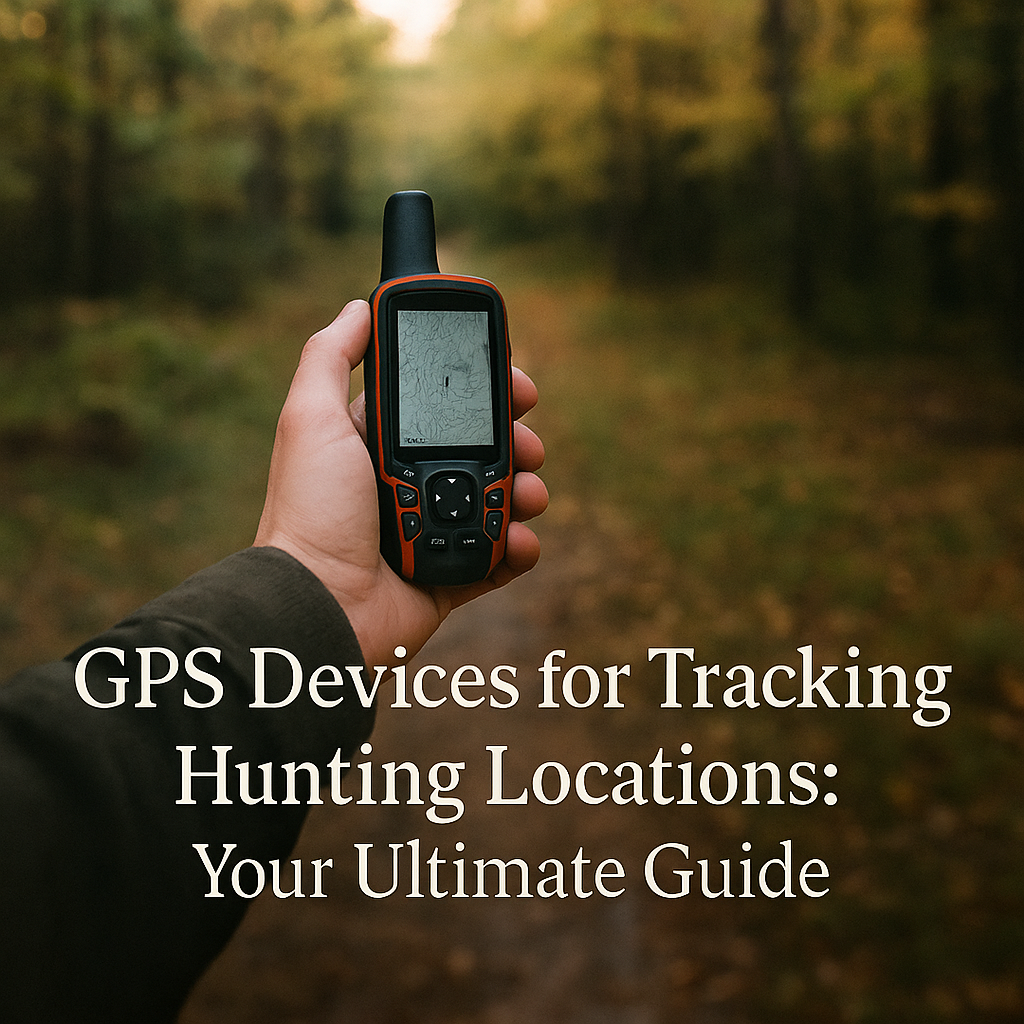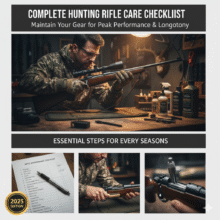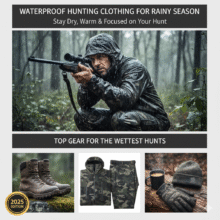GPS Devices for Tracking Hunting Locations: Your Ultimate Guide

In the world of hunting and outdoor navigation, accuracy, reliability, and situational awareness are paramount. Whether you’re setting up tree stands, scouting trails, tracking game, or simply ensuring safe navigation back to camp, having a solid GPS device is no longer a luxury it’s essential gear. In this deep-dive guide, we’ll cover everything you need to know about GPS devices for tracking hunting locations: how they work, what features matter, types of devices, top models, best practices, and even how to use them in bowhunting or rugged terrain.
Table of Contents
Why Hunters Need GPS Devices
Before jumping into models and specs, let’s understand why GPS devices are so critical in hunting:
- Accurate Waypoint Marking
You can drop waypoints on locations like blinds, stands, water sources, travel routes, game trails, and retrieval sites. Later, you can return to those exact coordinates. - Route Tracking & RetracBack
Many GPS units record your path (“breadcrumb trails”) so you can retrace your steps — helpful if visibility drops, or terrain changes. This is especially useful in thick woods or unfamiliar backcountry. - Navigation in Remote Terrain
In places with no cell coverage or mapped roads, a dedicated GPS can guide you using topo maps, satellite imagery, and compass features alone. - Safety & Emergency
Some advanced units include SOS, satellite communication, or built-in messaging features. If you’re in trouble, these can be life-saving. - Data Collection & Sharing
You can record tracks, log routes, download maps, and often share waypoints with partners. This is useful for team hunts or mapping large properties. - Weather & Altitude Awareness
Many hunting GPS devices include altimeters, barometers, electronic compasses (often called “ABC sensors”) so you can track elevation changes, upcoming weather, and orientation.
Given these advantages, let’s explore what features matter when choosing a GPS.
Key Features to Look for in a Hunting GPS
When evaluating GPS devices for hunting, these are the most critical features you should prioritize. Always aim for gear that withstands rugged conditions.
| Feature | Why It’s Important for Hunting | What to Look For |
|---|---|---|
| Satellite Constellation & Frequency | More satellites = better accuracy and more stable signal in cover | Dual-frequency (L1 + L5 or multiband) or support for GPS + GLONASS + Galileo |
| High-Sensitivity Receiver | Maintains fix under dense tree cover, deep valleys | Units with HotFix or advanced signal acquisition features |
| Waypoint & Track Log Capacity | To mark many hunting sites and record routes over days | Support for 10,000+ waypoints and thousands of track points |
| Topo Maps / Satellite Imagery / Map Support | For visual navigation and terrain understanding | Preloaded topo maps, ability to load custom maps, BirdsEye imagery |
| Battery Life / Power Options | You might be in the field for days | Long-lasting battery, support for AA or external battery packs |
| Durability / Waterproofing | Hunting environments are rough—rain, mud, drops | Rugged build, MIL-STD ratings, IPX water resistance |
| Navigation Features | Useful tools beyond just coordinate readouts | Features like TracBack, route planning, 3D view, compass & altimeter |
| Communication & SOS | For safety or team coordination | InReach, satellite texting, two-way messaging, SOS (if legal in your region) |
| Size & Usability | You want a device that fits your hunting style | Handheld vs wrist-mounted vs clip-on, screen readability in daylight, button or touchscreen |
Types of GPS Devices for Hunting
GPS systems for hunting tend to come in several formats. Each has pros and trade-offs:
- Handheld GPS Units
These are full-featured, rugged devices with larger screens, map support, and robust navigation tools. They are the most common choice for serious hunters.
Pros: excellent screen, strong navigation features, room for maps, durable.
Cons: bulkier, heavier, limited runtime (depending on model). - Wrist or Wearable GPS
Compact, hands-free units (often wristwatch style). These are great for mobile hunts, but often lack full map detail.
Example: Garmin Foretrex series. - Satellite Communicator GPS / Hybrid Devices
These combine GPS with satellite messaging and SOS functions. Useful where cell coverage is nonexistent.
Examples: Garmin inReach devices. - Phone + GPS Apps
Many hunters use smartphone apps like OnX Hunt. These are convenient, but at risk of battery drain, signal issues, and device fragility.
One user notes: “…I now use OnX Hunt with my phone for most hunts … the Garmin wins because I can carry extra AA batteries and it’s more weather-resistant than my phone.” - Dog-Collar GPS Trackers
If you hunt with dogs, GPS collars allow you to monitor your dog’s location in real time.
Example: Tracker (Luna, Bark) offers GPS dog tracking with 4G and real-time updates.
Top GPS Devices for Hunters (2025 Update)
Here are some of the best GPS devices popular among hunters right now. These are frequently recommended in gear reviews and hunting forums.
| Device | Strengths / Key Features | Drawbacks / Considerations |
|---|---|---|
| Garmin GPSMAP 66i | Full-featured handheld with topo maps, BirdsEye imagery, inReach messaging, SOS, ABC sensors. Considered “one device to do it all.” | Pricey; battery life is moderate |
| Garmin inReach Mini 2 | Ultra-compact satellite communicator + GPS track logging, ideal for backcountry use. | Very small screen, limited mapping |
| Garmin eTrex 10 / eTrex 32x | Affordable, reliable, basic mapping, good for entry-level use. | Less feature-rich; simpler display |
| Garmin Montana 700i | Big touchscreen, strong battery life, inReach-enabled, glove-friendly UI. | Larger size; high cost |
| Garmin Foretrex 801 | Wrist-mounted, hands-free, sturdy unit for mobile hunters. | No detailed maps; small display |
| Trackers (dog GPS collars) | Specialized tracking for hunting dogs (Luna, Bark). | Only tracks dog, not general navigation |
These devices cover a broad spectrum from full-featured handhelds with communication to compact wearables. Choose depending on your hunting style, terrain, and communication needs.
Best Practices for Using GPS in Hunting
Having a top-tier GPS device is one thing; using it optimally is another. Here are tips to get the most from your gear and avoid common mistakes:
1. Preload Maps & Waypoints
Before heading out, load topo and satellite maps of your hunting area. Mark key waypoints—stands, trails, watering holes—to save time and reduce guesswork in the field.
2. Use Waypoint Naming Convention
Use a consistent naming system (e.g., “TR01_StandNorth”, “WS_pond4”) so you can quickly identify points on the unit.
3. Track in Intervals
Set your track-log interval appropriately (e.g., every 5–10 seconds) to conserve memory and battery. Too frequent logging may overfill memory.
4. Use TracBack / Route Navigation
When heading back to base or truck, use “TracBack” or route-follow tools to retrace your steps, especially in poor visibility or dense cover.
5. Carry Redundant Power
Bring spare batteries or a power bank. Many GPS units support AA battery options or external USB power.
6. Practice Before the Hunt
Get familiar with your device’s interface, buttons, and map features before you rely on it in real conditions. Practice dropping waypoints, navigating routes, and rescuing lost signals.
7. Use SOS / Satellite Features Wisely
If your unit includes an SOS or satellite messaging function, test it (in non-emergency mode if possible), so you know exactly how it works.
8. Manage Battery Life
Switch off features (like backlighting, wireless) when not needed. Use “battery-saving” or “expedition” modes if the device supports them.
9. Update Firmware & Maps
Manufacturers often release firmware updates and map upgrades to improve performance and accuracy. Keep yours up-to-date.
10. Be Skilled with Traditional Navigation
Don’t rely solely on electronics. Always carry a paper map, compass, or know basic navigation skills — GPS can fail or lose signal.
Special Use Cases: Bowhunting & Big Game Terrain
As a site dedicated to shooting, hunting, and bows, here are some specialized tips for bowhunters and hunters in rugged terrain:
- Micro-waypoints near stands: Place waypoints just a few meters from tree stands or blinds so you can navigate tightly spaced areas without guessing.
- Elevation and slope awareness: Use the altimeter/barometer features to understand terrain slope changes—useful when stalking uphill or downhill.
- Wind and weather tracking: Some GPS units paired with satellite weather features or barometric trend data can help you anticipate wind shifts or storms.
- Quiet movement: Select “silent” modes if your GPS has notification tones. You don’t want beeps spooking game.
- Scouting in advance: Use your GPS during scouting trips to plan approach routes that minimize disturbance. Then you can use those exact paths in-season.
Common Challenges & How to Overcome Them
Even the best GPS devices can run into issues in hunting environments. Here are common challenges and ways to mitigate them:
| Challenge | Cause | Solution / Best Practice |
|---|---|---|
| Losing satellite fix under canopy | Dense tree cover or steep terrain blocking line-of-sight | Use high-sensitivity units, wait for better signal, relocate slightly to get clear sky |
| Draining battery too fast | Bright screen, wireless features, continuous track logging | Reduce screen brightness, disable wireless, use lower logging frequency |
| Misplaced waypoints | Typing or point error | Walk up and verify waypoint on foot, or drop multiple points to bracket |
| Map inaccuracies | Outdated maps or mismatched datum | Update maps, ensure device coordinate system matches map datum |
| Bagged memory or overloaded logs | Running out of storage mid-hunt | Clear old tracks, offload logs to computer, or use external microSD cards |
| Legal/regulatory limitations | Some areas may restrict satellite devices or electronics | Check local laws and hunting regulations |
Conclusion
When it comes to GPS devices for tracking hunting locations, the difference between success and frustration often lies in your gear choice and how well you use it. A well-chosen GPS helps you navigate confidently, mark and revisit the best spots, hunt more efficiently, and stay safer in remote terrain. Whether you opt for a feature-rich handheld unit, a compact wearable, or a satellite-enabled communicator, focus on features that suit your hunting style: battery life, map support, ruggedness, and ease of use.
If you’re ready to take the next step, check out your preferred GPS models, read full reviews, and test them before hitting the field. On TheShootingGears.com, you can expect upcoming posts with “GPS device comparisons”, “how-to drop waypoints in the field”, and “GPS + trail camera combo setups”—so stay tuned.







